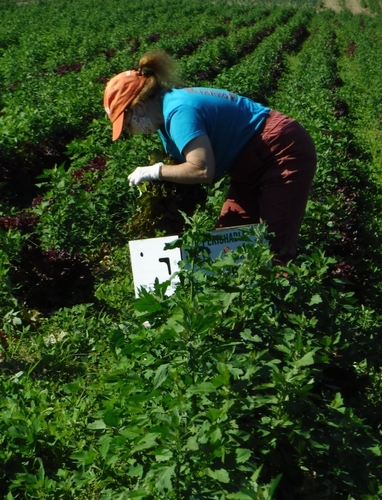WESTMINSTER WEST — A picture says a thousand words, and it was a recent photo in The Commons that caught my attention.
I saw a bountiful field full of green plants which, on closer inspection, proved to be lamb's quarters. Hidden deep in these weeds, as in my own garden, was a second crop, red lettuce.
Eagerly, I looked at the caption and was delighted to discover that this was at one of the Harlow farms. Wow, their gardens look just like mine.
But something was wrong - not with the picture, but with the whole gleaning project that was the subject of the story that accompanied the photo.
Lovely, caring, charitable workers were filling boxes with red lettuce heads - tasty, to be sure, but nowhere near the nutritional bargain of lamb's quarters, which are a rich source of vitamins A, C, and K and are high in protein. They are in the amaranth family, can be used as you would spinach, are delicious and substantial, and - even more important - they can be frozen or dried for use later, which lettuce cannot.
In the interest of reducing food waste and hunger, the gleaners were leaving the better crop behind in the field.
* * *
My passion for this is hard-won. I had to redefine garden success this year after many desired crops failed to germinate.
Asian greens are not going into my freezer in 2020. But what sprouted instead, bountifully, were the greens that belong here, the so-called weeds.
Lamb's quarters can be bought for a long price at farmers' markets, or they could be, back when life was what we used to call normal.
Processing is minimal; strip the leaves from the tough stalks and blanch them for a minute or so in boiling water. Then freeze them or get out a cookbook.
Don't use the leaves in salads; they have a grainy texture on the underside that disappears with cooking. I like to cook them with onions and garlic in a little butter, add salt and pepper and nutmeg, then grate in some cheese.
Delicious! Like stovetop vegetable nachos. They fill the belly and feed the soul, with all those vitamins boosting health in countless ways.
* * *
Given the vast volunteer enthusiasm of lamb's quarters, I would guess that many vegetable fields and gardens in New England look just like this picture.
It's healthy for the Earth to have those roots in the soil, taking carbon out of the air and storing it underground, sheltering the delicate lettuce and the subterranean microbes. It could also be healthy for people, and greatly increase the productivity of the field. The technique is called “intercropping,” but in this case, one of the crops - the most nutritious one - is being ignored.
If your garden looks like Harlow's, go out there with scissors and cut down some lamb's quarters to try. It takes a lot, because only the leaves are used, but don't be afraid to cut the plants. They re-sprout as vigorously as they self-seed, and after you taste them, you'll be glad of that.
* * *
When you've used lamb's quarters in some favorite greens recipes, take another look at that gleaning photo, and the hundreds, perhaps thousands, of bushels of food that will never even be harvested. Think about hunger, and food waste.
As a child, I used to laugh at an aunt who was a staunch advocate for eating weeds. I wasn't a gardener then. I didn't appreciate the plants that come up without care or expense.
I didn't grow up in poverty, as she did, and I didn't understand the skills she had acquired. A garden as I understood it was clean-cultivated, weedless, with crops in straight rows under the blazing sun.
I hated gardening. But sometimes it's how you define things that matters most, and these days, if it's growing, if I can eat it, and if it's feeding the soil, I'm happy - though I still want to succeed with tatsoi.
The Earth is putting food in front of us all the time here in Vermont. Dandelions, nettles, elder, lamb's quarters, pigweed, quickweed. Like fussy toddlers, we push it away.
Maybe it's time to stop doing that - time to accept all the bounty we are offered, and to say a heartfelt thanks.
